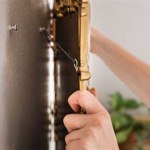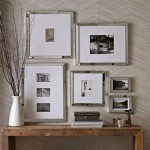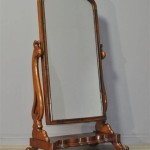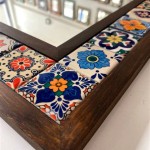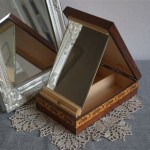How To Hang A Very Heavy Mirror
Hanging a heavy mirror is a project that requires careful planning, the right tools, and a thorough understanding of wall structure. Unlike lighter decorative items, a heavy mirror poses a significant safety risk if improperly mounted. The weight can easily overwhelm inadequate hanging systems, leading to the mirror falling and potentially causing damage, injury, or even death. This article will provide a comprehensive guide to safely and securely hanging a very heavy mirror, ensuring it remains in place for years to come.
Before beginning, it's crucial to acknowledge the definition of "very heavy." While a precise weight is subjective, for the purposes of this guide, we will consider a "very heavy mirror" to be one exceeding 25 pounds. Mirrors of this weight class demand hardware and techniques specifically designed to bear the load. Ignoring this weight and opting for standard picture-hanging solutions is a recipe for disaster.
The following steps outline the process, from initial assessment to final adjustments. Remember to always prioritize safety and consult with a professional if you are unsure about any aspect of the process.
Key Point 1: Assessing The Wall And Choosing The Right Location
The foundation of a successful heavy mirror installation is a thorough assessment of the wall itself. The type of wall construction directly dictates the appropriate hanging hardware and techniques. Common wall types include drywall, plaster, and masonry (brick or concrete). Each poses unique challenges and requires specific solutions.
Drywall, also known as sheetrock or gypsum board, is the most common wall material in modern homes. It is relatively inexpensive and easy to install, but it is not inherently strong. It is generally not capable of directly supporting heavy weights without reinforcement. Simply screwing into drywall will almost certainly result in the mirror pulling away from the wall.
Plaster walls, common in older homes, are stronger than drywall but can be brittle and prone to cracking. Secure hanging requires careful drilling techniques and hardware designed to grip the plaster without damaging it further. Plaster walls often have wood lath behind them, which can provide a more secure fixing point.
Masonry walls, such as brick or concrete, are the strongest and most capable of supporting significant weight. However, drilling into these materials requires specialized tools and techniques. Regular drill bits will not penetrate masonry; you'll need a hammer drill and masonry drill bits.
Beyond the wall material, it is vital to locate wall studs. Studs are vertical wooden beams that provide structural support within the wall. They are typically spaced 16 or 24 inches apart. Attaching the mirror directly to a stud is the most secure option, as the wood provides a solid anchor point. Stud finders, readily available at hardware stores, can help locate these studs. Electronic stud finders detect changes in density within the wall. Magnetic stud finders locate screws or nails securing the drywall to the studs.
If a stud cannot be used, or if the mirror needs to be hung in a specific location away from a stud, alternative anchoring methods must be considered. These will be discussed in detail later.
The location of the mirror itself is also a critical consideration. Think about the purpose of the mirror and the desired visual effect. Consider the height at which the mirror will be hung. Eye level is generally recommended, but this will vary depending on the size of the mirror and the height of the people who will be using it. Be aware of lighting conditions, as glare can make the mirror less effective. Finally, consider any potential obstructions, such as furniture or doorways.
Key Point 2: Selecting The Appropriate Hanging Hardware
Once the wall type and desired location are determined, the next step is selecting the appropriate hanging hardware. The hardware must be rated to support the weight of the mirror and compatible with the wall material.
For hanging on a stud, heavy-duty screws are essential. Use screws that are long enough to penetrate at least 1.5 inches into the stud. The screw head should be large enough to securely grip the hanging hardware on the back of the mirror. Ensure the screw is rated to hold at least the weight of the mirror. Predrilling a pilot hole slightly smaller than the screw diameter is recommended to prevent the wood from splitting.
If studs are not accessible, several anchor types are available for use in drywall and plaster. These anchors provide a more secure hold than simply screwing into the wall. Types and load capacities vary, so carefully select an anchor that is rated to exceed the weight of the mirror. Some common anchor types include:
*Drywall Anchors (Self-Drilling):
These anchors are designed to be screwed directly into drywall without pre-drilling. They have sharp points that pierce the drywall and threads that grip the material. While convenient, they are generally not suitable for very heavy mirrors unless multiple anchors are used. *Toggle Bolts:
Toggle bolts consist of a bolt and a spring-loaded wing that expands behind the wall. They are inserted through a pre-drilled hole, and the wings open up inside the wall, providing a large bearing surface. Toggle bolts are one of the strongest options for drywall and plaster, capable of supporting significant weight. Ensure that the hole is large enough to accommodate the folded wings, but no larger than necessary. *Molly Bolts:
Molly bolts consist of a bolt and a sleeve that expands behind the wall. When the bolt is tightened, the sleeve collapses and grips the back of the drywall. Molly bolts are a reliable option for medium-weight applications. *Heavy-Duty Anchors (Metal):
These anchors are designed for heavier loads and typically require pre-drilling. They often feature a spreading mechanism that distributes the weight across a larger area of the wall.For masonry walls, specialized anchors are required. These anchors are designed to expand and grip the concrete or brick. Types of masonry anchors include:
*Sleeve Anchors:
Sleeve anchors consist of a bolt surrounded by a metal sleeve. When the bolt is tightened, the sleeve expands and grips the inside of the hole. *Wedge Anchors:
Wedge anchors are similar to sleeve anchors but use a wedge-shaped clip to provide a stronger grip. *Concrete Screws:
These are self-tapping screws specifically designed for use in concrete. They require a pre-drilled pilot hole and are driven directly into the concrete.In addition to the wall anchors, consider the hanging hardware on the back of the mirror itself. D-rings or wire are common options, but for very heavy mirrors, heavy-duty D-rings with multiple screw holes are recommended. The wire, if used, should be thick and rated to support the weight of the mirror. Consider replacing the existing hardware with stronger options if necessary. French cleats can also be used for very heavy mirrors. They provide excellent weight distribution and simple installation.
Key Point 3: Performing The Installation And Ensuring Stability
With the wall assessed and the appropriate hardware selected, the installation process can begin. Accuracy and attention to detail are paramount to ensure a secure and level installation.
Begin by marking the desired location of the mirror on the wall. Use a level to ensure that the mark is straight. If using a stud finder, verify the location of the stud with a small nail to confirm you are indeed hitting solid wood. If using anchors, mark the locations for the anchor holes according to the manufacturer's instructions. Use a pencil to mark the locations, as it is easier to erase if needed.
Drilling the pilot holes is a crucial step. If drilling into a stud, use a drill bit slightly smaller than the screw diameter. For anchors, use the drill bit size recommended by the anchor manufacturer. When drilling into drywall or plaster, apply gentle pressure to avoid cracking the wall. For masonry walls, use a hammer drill and a masonry drill bit. Apply firm, consistent pressure and allow the drill to do the work. Avoid forcing the drill, as this can damage the drill bit or the wall.
Once the pilot holes are drilled, install the anchors according to the manufacturer's instructions. For toggle bolts, fold the wings and insert them through the hole. Once the wings are behind the wall, they will spring open. Tighten the bolt until the wings are snug against the back of the wall. For molly bolts, insert the bolt and tighten it until the sleeve collapses and grips the back of the wall. For masonry anchors, insert the anchor into the hole and tighten the bolt until it is secure.
With the anchors installed, it is time to hang the mirror. Carefully lift the mirror and position it over the anchors or screws. Ensure the hanging hardware on the back of the mirror is properly aligned with the anchors or screws. Gently lower the mirror onto the hanging hardware. Ensure it is securely resting on the fasteners.
After the mirror is hung, use a level to check if it is perfectly straight. Shims can be used behind the mirror to make adjustments. Small pieces of cardboard or wood can be placed between the mirror and the wall to level it.
Finally, test the stability of the mirror. Gently push on the mirror to ensure it is securely attached to the wall and does not move or wobble. If any movement is detected, re-evaluate the hanging system and make necessary adjustments. Consider adding additional anchors or using heavier-duty hardware if needed.
Hanging a heavy mirror is a task that demands careful planning, accurate execution, and a keen understanding of wall structure and hardware capabilities. By following these guidelines and prioritizing safety, a very heavy mirror can be securely mounted, enhancing the aesthetic and functionality of a room for years to come.
:max_bytes(150000):strip_icc()/how-to-hang-heavy-mirror-4842125-08-c35627d37fdb44678b20c10d589bdbb4.jpg?strip=all)
How To Hang A Heavy Mirror
/how-to-hang-heavy-mirror-4842125-12-1311d4483fa8487e98724cdb1aee3771.jpg?strip=all)
How To Hang A Heavy Mirror

How To Hang A Heavy Mirror C R F T

How To Hang A Large Or Heavy Mirror

A Better Way To Hang Heavy Mirror Hanging Pictures On The Wall
How To Hang A 100 Pound Mirror On Drywall Quora

How To Hang A Heavy Mirror Lowe S

How To Hang A Heavy Mirror Or Picture She Holds Dearly

How To Hang A Heavy Mirror The Home Depot

How To Hang A Heavy Mirror With Pictures Wikihow


